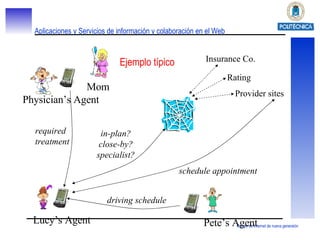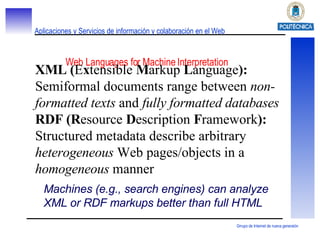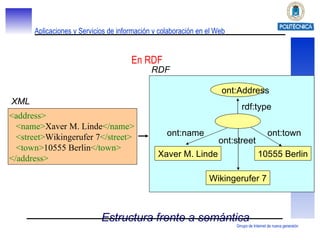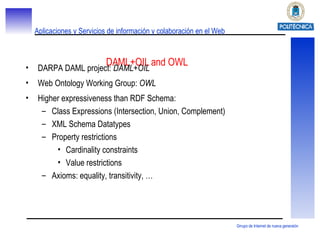06 Busqueda
- 1. Aplicaciones y Servicios de información y colaboración en el Web Joaqu ín Salvachúa Antonio Fumero Dpto. de Ingenier ía de Sistemas Telemáticos E. T. S. I. de Telecomunicación Universidad Politécnica de Madrid
- 3. Interactivo
- 4. Aplicaciones Web frente a Aplicaciones PC Necesidad de Instalar un programa. Problemas de las actualizaciones
- 6. Compartir buscar Al estar los datos de otros usuarios en el servidor se pueden buscar y compartir. En el PC es necesario tener protocolos complejos para la misma funcionalidad.
- 7. long tail The long Tail
- 8. ZIPF
- 10. Estanterias
- 12. buscar
- 13. Google pagerank
- 14. Grafos (Euler)
- 15. web semántica
- 16. El web Semantico Visión definida por Tim Berners-Lee (1997) “ The Semantic Web is an extension of the current web in which information is given well-defined meaning, better enabling computers and people to work in cooperation.” T. Berners-Lee, J. Hendler, O. Lassila, “The Semantic Web”, Scientific American, May 2001
- 17. El Web actual Inventado por Tim Berners-Lee en 1989 Idea principal: combination of Hypertexto Internet URI: evolución de URL a identificador global. HTTP / HTML: protocolo y datos del hipertexto. Para ver en un navegador (posterirmente).
- 18. Objetivos de Web Semántico La información sea comprensible para personas y maquinas. No solo representarla en la pantalla. “ The Semantic Web will bring structure to the meaningful content of Web pages, creating an environment where software agents roaming from page to page can readily carry out sophisticated tasks for users.” T. Berners-Lee, J. Hendler, O. Lassila, “The Semantic Web”, Scientific American, May 2001
- 19. Ejemplo típico Mom Physician’s Agent Lucy’s Agent required treatment schedule appointment Insurance Co. Provider sites Rating in-plan? close-by? specialist? Pete’s Agent driving schedule
- 20. La TRANSPARENCIA
- 21. Web Languages for Machine Interpretation XML ( E x tensible M arkup L anguage ): Semiformal documents range between non-formatted texts and fully formatted databases RDF (R esource D escription F ramework ): Structured metadata describe arbitrary heterogeneous Web pages/objects in a homogeneous manner Machines (e.g., search engines) can analyze XML or RDF markups better than full HTML
- 22. Ejemplo Xaver M. Linde Wikingerufer 7 10555 Berlin <em> Xaver M. Linde </em><br> Wikingerufer 7 <br> <strong> 10555 Berlin </strong> <address> <name> Xaver M. Linde </name> <street> Wikingerufer 7 </street> <town> 10555 Berlin </town> </address> Representación frente a Estructura external HTML XML
- 23. En RDF <address> <name> Xaver M. Linde </name> <street> Wikingerufer 7 </street> <town> 10555 Berlin </town> </address> Estructura frente a semántica XML ont:Address rdf:type Xaver M. Linde Wikingerufer 7 10555 Berlin ont:name ont:street ont:town RDF
- 24. RDF —Resource Description Framework <ont:Address> <ont:name>Xaver M. Linde</ont:name> <ont:street>Wikingerufer 7</ont:street> <ont:town>10555 Berlin</ont:town> </ont:Address> Statements of the form <subjecto, predicate, objecto> Que pueden ser literales (strings) o URIs. El grafo tiene múltiples serializacione. Una de ellas en XML.
- 25. Dublin Core: estándar de metadatos Continene 15 elementos. Content Intellectual Property Instantiation Coverage Contributor Date Description Creator Format Type Publisher Identifier Relation Rights Language Source Subject Title Dublin Core Metadata
- 26. Ejemplo <?xml version="1.0"?> <!DOCTYPE rdf:RDF PUBLIC "-//DUBLIN CORE//DCMES DTD 2002/07/31//EN" "http://dublincore.org/documents/2002/07/31/dcmes-xml/dcmes-xml-dtd.dtd"> <rdf:RDF xmlns:rdf="http://www.w3.org/1999/02/22-rdf-syntax-ns#" xmlns:dc="http://purl.org/dc/elements/1.1/"> <rdf:Description rdf:about="http://www.ilrt.bristol.ac.uk/people/cmdjb/"> < dc:title >Dave Beckett's Home Page</dc:title> < dc:creator >Dave Beckett</dc:creator> < dc:publisher >ILRT, University of Bristol</dc:publisher> < dc:date >2002-07-31</dc:date> </rdf:Description> </rdf:RDF>
- 27. RDFS : un paso adelante Core Classes Root-Class rdfs:Resource MetaClass rdfs:Class Literals rdfs:Literal rdfs:subclassOf -property Inherited from RDF: properties (slots) rdfs:domain & rdfs:range rdfs:label , rdfs:comment , etc. Inherited from RDF: InstanceOf ( rdf:type )
- 28. RDFS: Example rdfs:Resource xyz:MotorVehicle rdfs:Class s s t t xyz:Truck s t xyz:PassengerVehicle s = rdfs:subClassOf t = rdf:type xyz:Van s s xyz:MiniVan s s t t t t
- 29. RDF/S: algunas aplicaciones .org (human-edited directory) .org (music encyclopedia) RSS (RDF Site Summary) (embedded metadata) CC/PP (Composite Capability/Preference Profiles) P3P (Platform for Privacy Preferences)
- 30. DAML+OIL and OWL DARPA DAML project: DAML+OIL Web Ontology Working Group: OWL Higher expressiveness than RDF Schema: Class Expressions (Intersection, Union, Complement) XML Schema Datatypes Property restrictions Cardinality constraints Value restrictions Axioms: equality, transitivity, …
- 31. (Semantic) Web Services Public process description and advertisement WSDL: Web Services Description Language UDDI: Universal Description, Discovery, and Integration of Business for the Web (SOAP: Simple Object Access Protocol) Discovery and Composition of Services DAML-S WSFL: Web Services Flow Language
- 32. No es la solución: Las personas mienten
- 33. Folksonomías frente a Ontologías
- 34. Flickr
- 35. del.icio.us
- 36. 43 things
- 37. 43 things (II)
- 38. 43 people
Notas del editor
- #2: Objeto del curso: Prácticamente no hay sistema de Defensa y Seguridad -sea de armas, de mando y control, de inteligencia, de transporte ...- que no se apoye en la transmisión y recepción de ondas electromagnéticas. En este contexto es lógico que la Guerra Electrónica (EW: “Electronic Warfare”), que incluye cualquier acción militar sobre el espectro electromagnético, se haya desarrollado exponencialmente desde la II Guerra Mundial hasta convertirse en un elemento imprescindible en los actuales escenarios de conflicto. En este curso se presentan los conceptos básicos, principios de funcionamiento y estructuras de los sistemas, así como sus características y prestaciones. El objetivo perseguido es que el asistente al mismo adquiera una visión unificada y completa de los sistemas utilizados y de sus capacidades, incluyendo las herramientas teóricas que permiten analizarlos. Duración: 20 horas Estructura: el curso se compone de cuatro temas autocontenidos y una conferencia con la que se pretende introducir la perspectiva industrial del tema. Sus contenidos han sido estructurados de acuerdo a criterios de carácter operativo, sacrificando algo el rigor metodológico en aras de un enfoque eminentemente práctico. Por último se puede comprobar que las técnicas radiogoniométricas, uno de los elementos esenciales del combate electrónico, no se ha incluido en este curso dado que ya fue objeto del curso SISTEMAS SENSORES, impartido con anterioridad dentro de la especialidad.






































